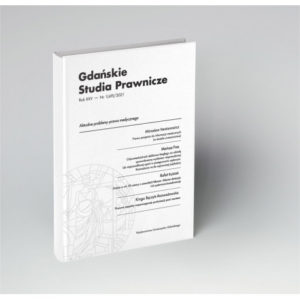Opis
Fundamentals of classical and analytical mechanics
Autor: Lipiński Krzysztof
Wydawnictwo Politechniki Gdańskiej
The primary intention of Author of the present book was to draw up a monographic picture of the contemporary attempts used to describe the Newtonian and Lagrangian Mechanics. But concurrently, the book can be recognized as a supplementary educational material, useful for the graduate courses in Mechanics taken by students majoring in Mechanical Engineering, Civil Engineering or Physical Science.
A short synopsis of the subsequent chapters follows:
- Few words of introduction focusing on the domain, branches and the primary assumptions of mechanics;
- A brief introduction to the fundamental concepts and principles of algebra of vectors;
- Kinematics of particles, mainly focused on non-Cartesian coordinates used in mathematical descriptions of kinematics;
- Dynamics of particles; focused on Newton’s laws of motion; motion of particles in one and in three dimensions; dynamics expressed in inertial and non-inertial frames of reference; the principles of linear momentum and of angular momentum of particle; work and energy principles;
- Chapter 5. Kinematics and dynamics of spherical motion of rigid bodies; Euler’s angles; angular velocities and angular accelerations; conical surfaces of angular velocity vectors, steady precession, angular momentum of bodies in their spherical motion, Euler’s equations of dynamics for bodies in their spherical motion; kinetic energy formulae;
- Kinematics and dynamics of general motion of rigid bodies; linear velocity and linear acceleration of points that belong to the same body; linear and angular momentum of rigid body; Newton-Euler’s dynamics equations; kinetic energy;
- Simplified theory of gyroscope;
- Mechanics expressed with use of Lagrange’s formalism; constraints and the constraint equations; main principles used in classifications of the constraints; generalized coordinates; virtual displacements and consequences of the virtual work principle; virtual velocities and the virtual power; generalized forces and the generalized equation of dynamics (d’Alembert’s principle); two types of Lagrange’s equations; selected alternative principles of equilibrium.
CONTENTS
Preface ……. 7
1. Introduction………… 11
2. Theory of Vectors…… 15
2.1. Basic Properties and Operations…. 19
2.2. Scalar Product of Vectors ……. 27
2.3. Vector product of Vectors …..33
2.4. Triple Scalar Product…….. 41
2.5. Triple Vector Product……. 44
2.6. Vector-valued Functions……. 45
3. Kinematics of particles…….. 47
3.1. Position vector …….. 48
3.2. Main cases of dedicated and limited sub-problems …… 49
3.3. Vector of linear velocity ……. 50
3.4. Vector of linear acceleration …… 52
3.5. Kinematics expressed in curvilinear coordinates…… 52
3.6. Trajectory attached coordinates and Frenet’s trihedron… 53
3.7. Velocities and accelerations expressed in the intrinsic coordinate
system (in the tangent/normal coordinates)……. 56
3.8. Polar Coordinates ……….. 65
3.9. Cylindrical Coordinates…….. 69
3.10. Spherical Coordinates…….. 71
3.11. Relative motion, transport motion and the transport theory…. 77
4. Dynamics of particles………. 93
4.1. Newton’s first law of mechanics and inertial frames of reference ….. 94
4.2. Newton’s second law of mechanics; inertia; masses and forces…… 94
4.3. Static equilibrium…… 96
4.4. Kinetostatics ……… 96
4.5. Dynamics in noninertial reference systems…….97
4.6. Relative equilibrium……… 100
4.7. Linear momentum……… 100
4.8. Angular momentum……. 103
4.9. Work and energy……..105
4.10. Variable mass objects and their dynamics equation….. 115
5. Spherical motion of rigid bodies ……… 118
5.1. Direction cosine matrix…………… 119
5.2. Attitude parameters in description of spherical motion……… 120
5.3. Euler’s Angles…….. 124
5.4. Transformation matrices related to individual Euler’s angles …… 126
5.5. Coordinates of vectors resolved in different frames …. 128
5.6. Angular velocity …… 129
5.7. Angular velocities of Euler’s angles …….. 131
5.8. Linear velocities of points of the moving body……. 137
5.9. Angular acceleration…….. 140
5.10. Linear acceleration of points of the moving body…. 141
5.11. Conical surfaces formed by instantaneous axes of angular velocity……. 145
5.12. Steady precession……….. 148
5.13. Angular momentum of body in spherical motion…… 156
5.14. Time derivative of angular momentum ….. 163
5.15. Dynamics equations ……….. 166
5.16. Kinetic energy ……….. 170
6. General motion of rigid bodies…… 173
6.1. Parameters of the general displacement …….. 174
6.2. Linear velocity and linear acceleration of generic point
of the moving body…… 175
6.3. Linear momentum of rigid body …… 178
6.4. Angular momentum of rigid body ……. 180
6.5. Dynamics equations…….. 182
6.6. Kinetic energy……. 188
7. Simplified theory of gyroscope….. 193
8. Lagrange proposed reformulation of mechanics……. 202
8.1. Origins……… 202
8.2. Constraints ……… 204
8.3. Free and constrained mechanical systems ……… 209
8.4. Main categories of constraints ………209
8.4.1. Unilateral and bilateral constraints……. 209
8.4.2. Scleronomous and rheonomous constraints….211
8.4.3. Holonomous and non-holonomous constraints….. 213
8.4.4. Holonomous and non-holonomous mechanical systems …… 218
8.4.5. Total, partial and rigid-body constraints…… 218
8.4.6. Ideal and real constraints…… 219
8.5. Position based equations and their velocity based alternatives…… 222
8.6. Physical quantities used to describe poses of mechanical system……. 225
8.6.1. Degrees of freedom…………. 225
8.6.2. Generalizes coordinates…… 225
8.6.3. Functions that correlate different forms of generalized coordinates…… 229
8.6.4. Equations that correlate Cartesian coordinates and generalized
coordinates ………….. 230
8.6.5. Configuration space…….. 232
8.7. Virtual displacement and the virtual work principle……… 233
8.7.1. Admissible and non-admissible displacements of mechanical
systems……….. 234
8.7.2. Virtual displacements…….. 234
8.7.3. Fields of correlated virtual displacements…… 237
8.7.4. Virtual displacements resulting of spherical motion of rigid body….. 243
8.7.5. Virtual displacements and virtual works of real forces…… 247
8.7.6. The virtual work principle……….. 248
8.7.7. Equilibrium of rigid body – conditions resulting from the virtual
work principle …..250
8.7.8. Virtual displacements of generalized coordinates…….. 252
8.7.9. Changes of Cartesian components associated to virtual
displacements of generalized coordinates…… 254
8.7.10. Generalized forces and their rearranged virtual work formula …. 257
8.7.11. Generalized forces for systems acted upon by conservative forces …. 261
8.7.12. Virtual velocities…………… 264
8.7.13. The virtual power principle…… 268
8.7.14. The virtual work principle in case of motionless systems…. 271
8.7.15. Other formulas useful to confirm the equilibrium …… 275
8.8. Kinetostatics, virtual displacements and velocities……. 278
8.8.1. Relative equilibrium in rheonomous systems …….. 278
8.8.2. d’Alembert’s principle………… 282
8.8.3. Jourdin’s principle……….. 286
8.8.4. Dynamics resolved in generalized coordinates……… 288
8.9. Lagrange’s equations of dynamics……….. 292
8.9.1. Formulas useful in developments of Lagrange’s equations ….. 293
8.9.2. Lagrange’s equations of dynamics….. 296
8.9.3. Lagrange’s equations – case of conservative forces……… 299
8.9.4. Lagrange’s equations – case of both conservative and
non-conservative forces …….. 301
8.9.5. Lagrangian based reformulation of Lagrange’s equations….. 302
8.10. Dynamics expressed in dependent coordinates….. 303
8.10.1. Lagrange’s equations of the first kind……… 304
8.10.2. Generalized forces of constraints…….. 308
8.10.3. Dynamics of mathematical pendulum…… 314
8.10.4. Integration of the calculated accelerations……. 318
Farewells……………. 320
Bibliography …….. 321











Opinie
Na razie nie ma opinii o produkcie.